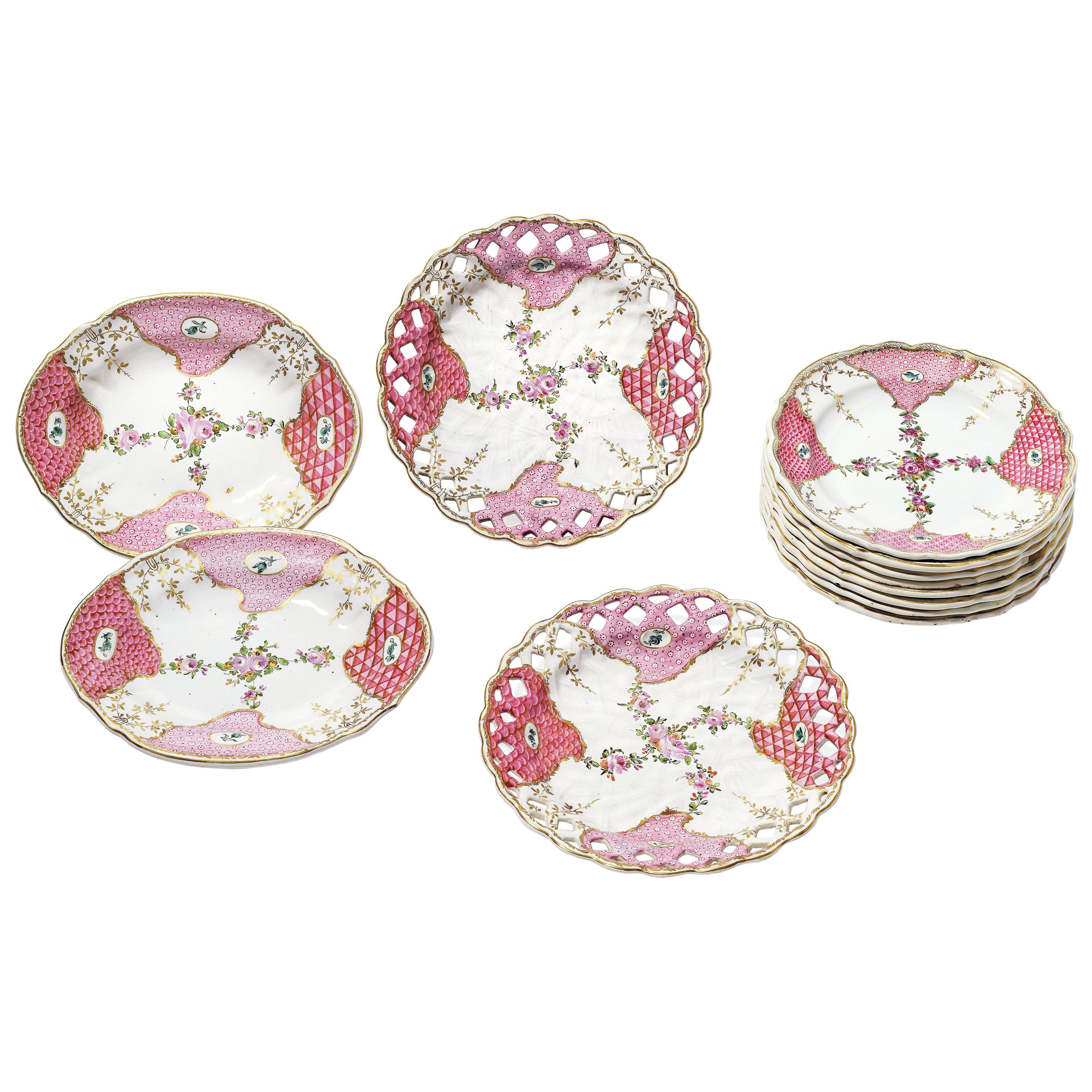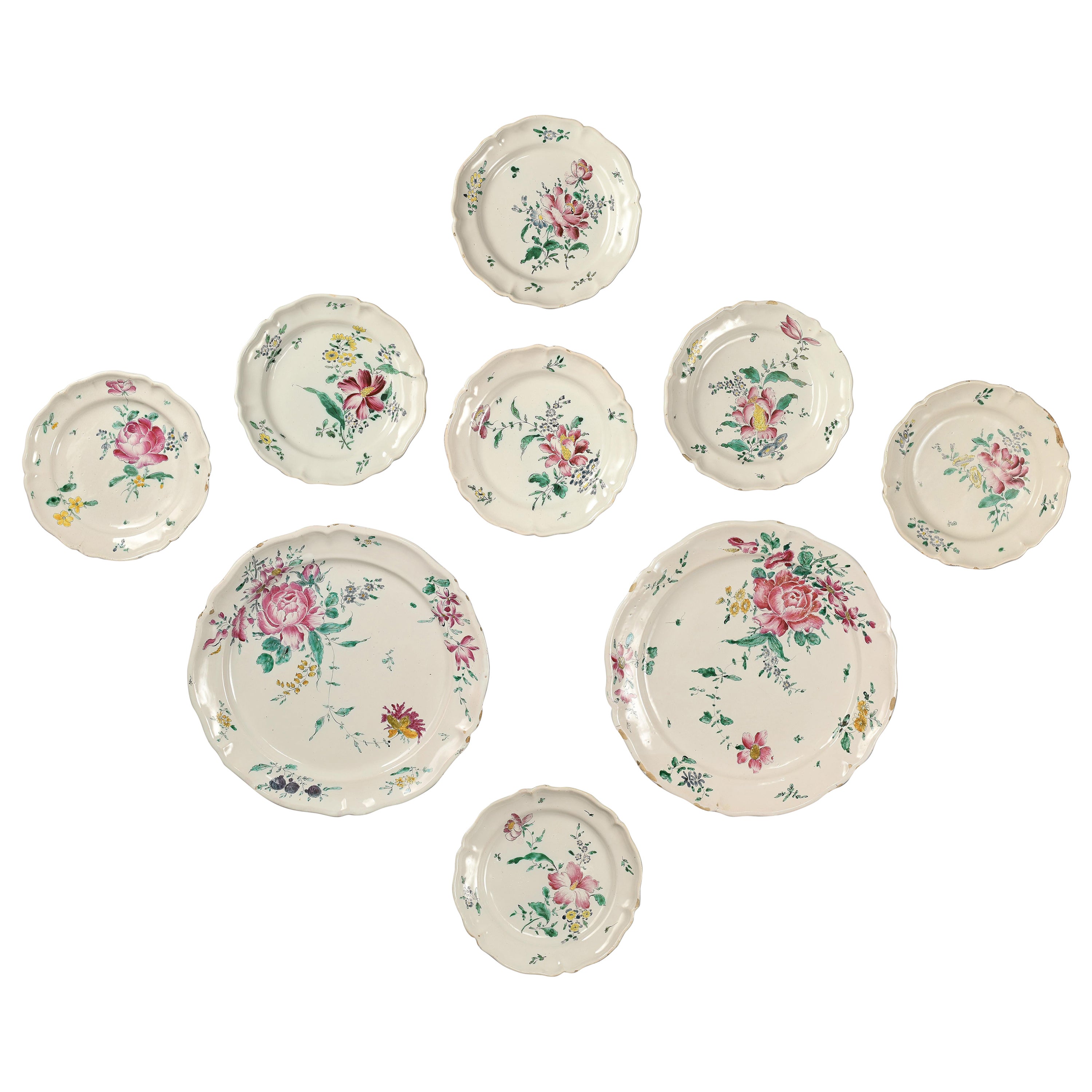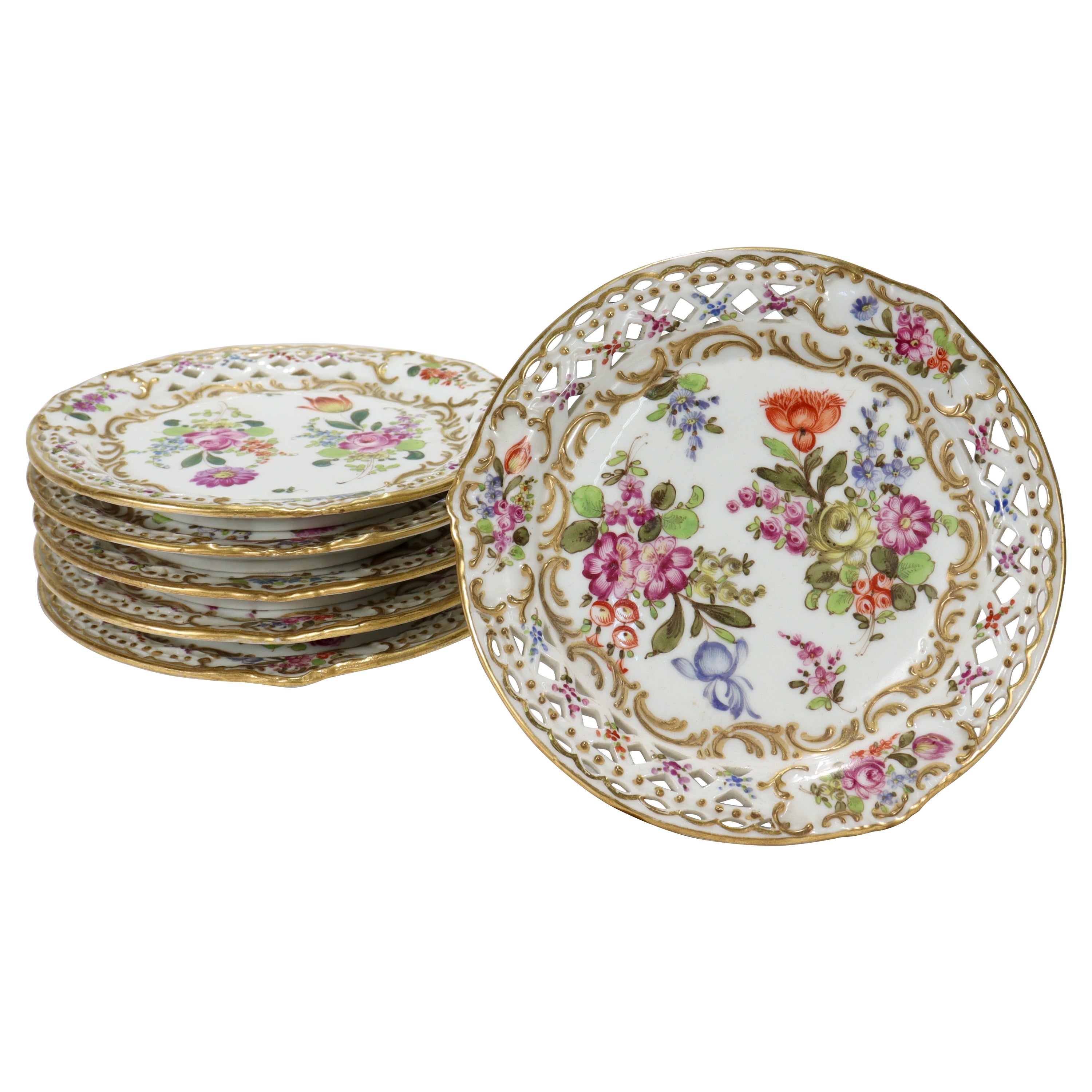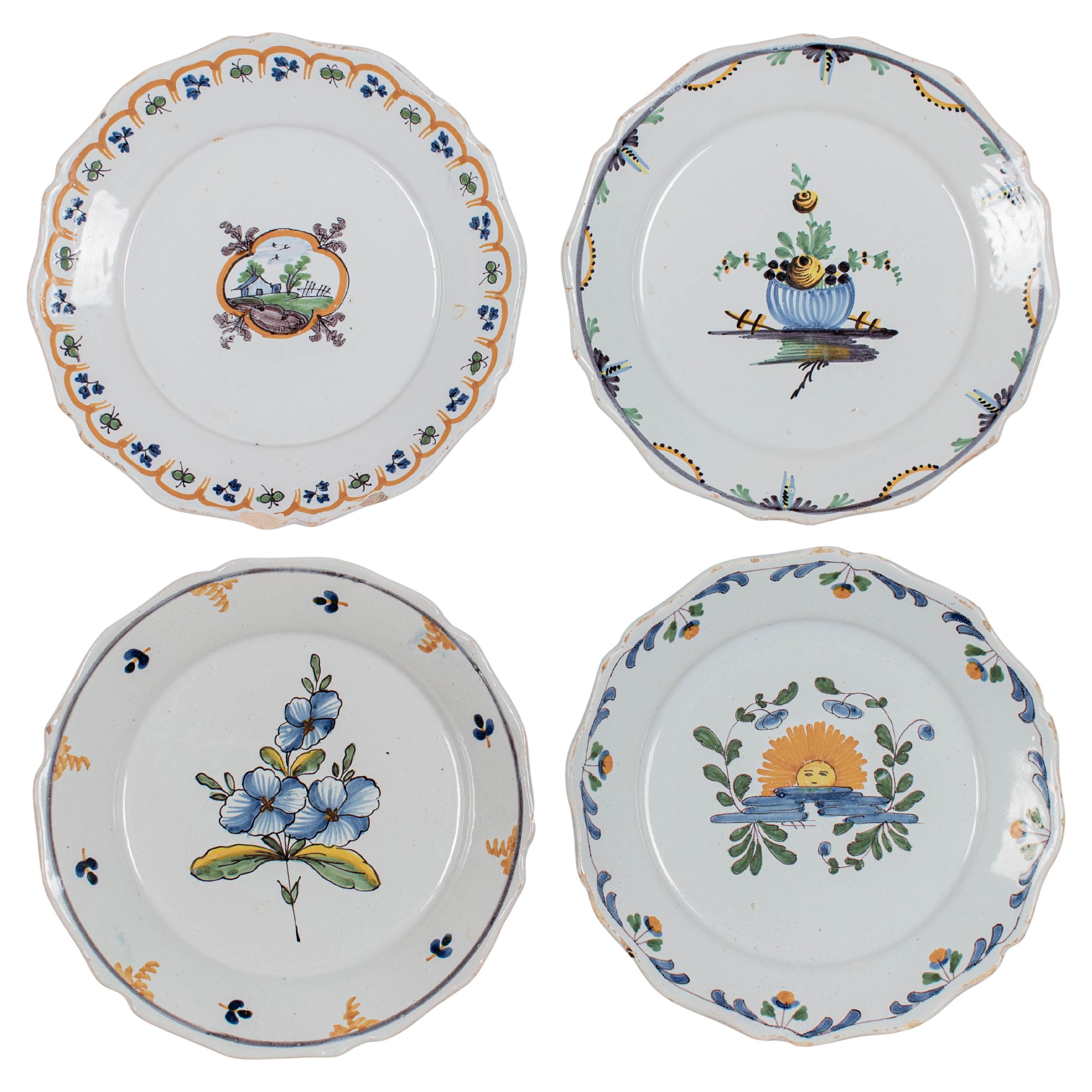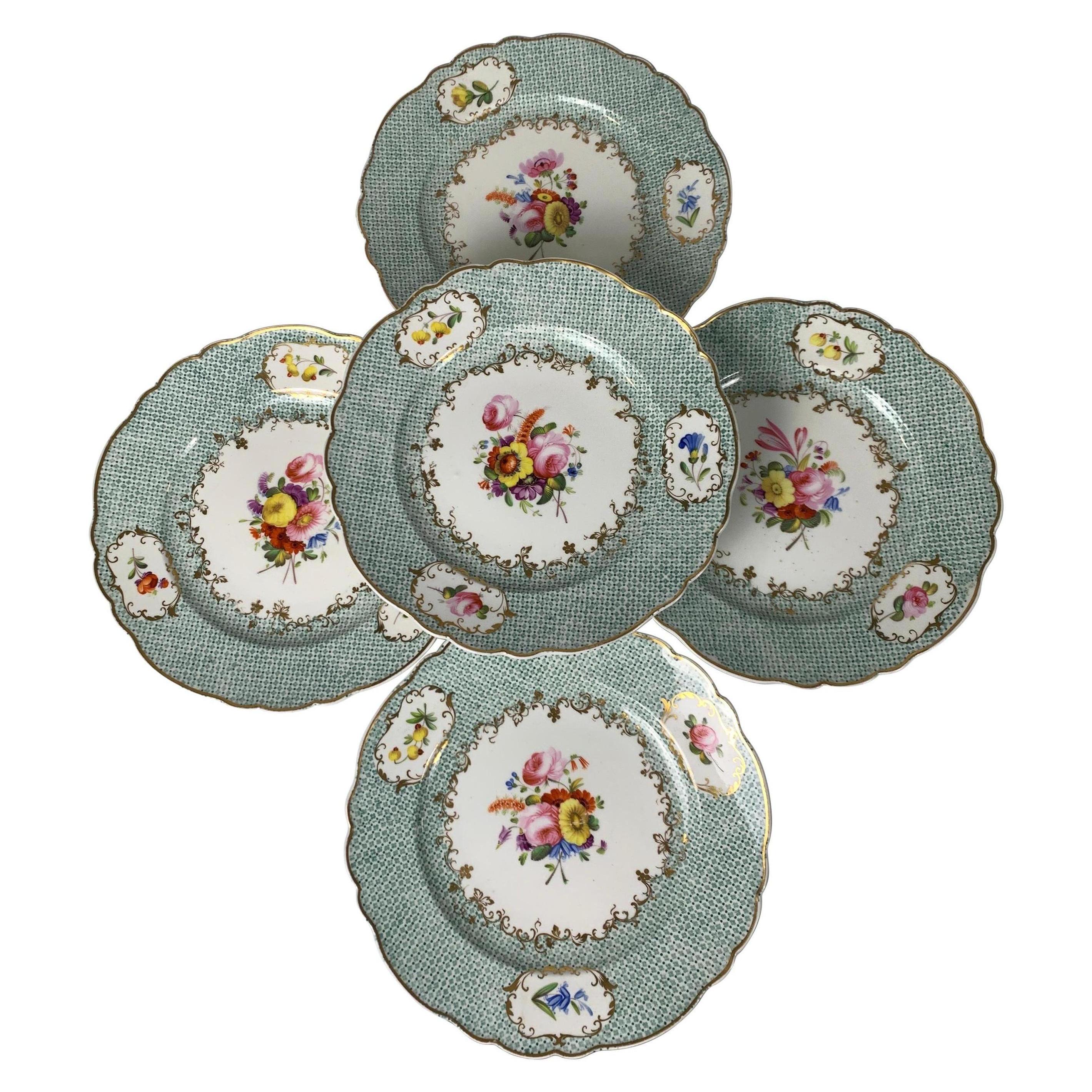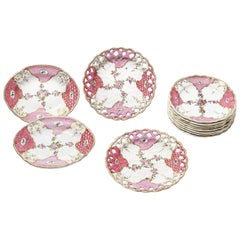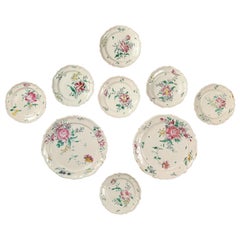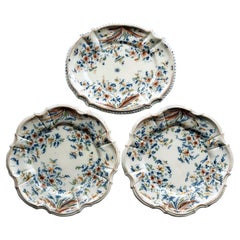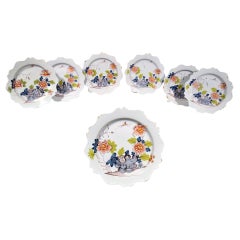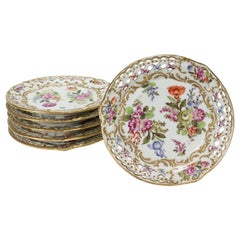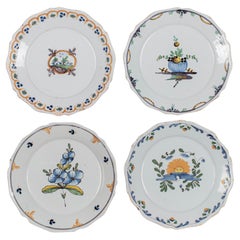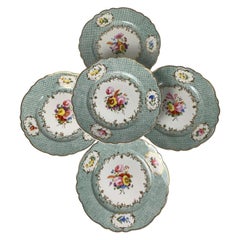Items Similar to Ancient Maiolica Plates Pasquale Rubati, Milan Circa 1770-1780
Video Loading
Want more images or videos?
Request additional images or videos from the seller
1 of 22
Ancient Maiolica Plates Pasquale Rubati, Milan Circa 1770-1780
$7,075.85per set
£5,296.45per set
€6,000per set
CA$9,738.38per set
A$10,854.44per set
CHF 5,694.95per set
MX$132,550.45per set
NOK 72,110.50per set
SEK 68,155.39per set
DKK 45,676.23per set
About the Item
Five oval maiolica dishes with pierced edge
Manufacture of Pasquale Rubati
Milan, 1770-1780
Three small oval dishes 10.23 in x 7.67 in (26 cm x 19.5 cm)
Two large oval dishes 10.82 in x 8.85 in (27.5 x 22.5 cm)
lb 3.5 (kg 1.8)
State of conservation: intact
The five dishes of different sizes have an oval shape, a mixtilinear edge and a molded polylobed shape with a surface enriched with a relief weave motif extending to the brim and forming a perforated basket-shaped ornamentation.
The decoration painted in the characteristic tones of the oriental Imari typology, red, blue with touches of gold, shows an idealized oriental landscape that develops around a perforated rock. From this stone, boughs branch off following arched courses and are adorned with peonies or with long lanceolate leaves. A fence completes the composition. The hem is decorated with a motif of a dense chain of eggs.
The Imari decoration, clearly inspired by the East, derives from Japanese productions that, by way of Chinese culture, came to the West where the taste for chinoiserie became widespread during the 18th century. At the Milanese factories the decoration took on various ornamental declinations, often distinguished solely by elements of morphological enrichment or distinguishable only by signed works.
In Milan in the 18th century, two majolica factories were active. The first was that of Felice Clerici, from 1745, and the second was opened by Pasquale Rubati in 1756, in competition with Felice, for whom he had been a worker. Upon Rubati's death, in 1796, the enterprise was continued for a few years under his son Carlo.
This type of decoration was produced by both Milanese factories, but its quality, the originality of the mold and the meticulousness in the realization of the motifs, lead us to confidently attribute the works to Pasquale Rubati's manufacture - to which we owe the most complex specimens - and date them to the 1770s, its most prosperous period (Ausenda R., by the Museums and Galleries of Milan. Museum of Applied Arts. The ceramics. Second tome. Milan 2001, pp. 318- 322, No. 315).
- Creator:Pasquale Rubati (Maker)
- Dimensions:Height: 1.38 in (3.5 cm)Width: 8.86 in (22.5 cm)Depth: 10.83 in (27.5 cm)
- Sold As:Set of 5
- Style:Rococo (Of the Period)
- Materials and Techniques:Maiolica,Glazed
- Place of Origin:
- Period:1770-1779
- Date of Manufacture:circa 1770
- Condition:Minor fading. Intact.
- Seller Location:Milano, IT
- Reference Number:1stDibs: LU4352216298671
About the Seller
4.3
Vetted Professional Seller
Every seller passes strict standards for authenticity and reliability
Established in 1860
1stDibs seller since 2018
21 sales on 1stDibs
Associations
International Confederation of Art and Antique Dealers' Associations
- ShippingRetrieving quote...Shipping from: Milano, Italy
- Return Policy
Authenticity Guarantee
In the unlikely event there’s an issue with an item’s authenticity, contact us within 1 year for a full refund. DetailsMoney-Back Guarantee
If your item is not as described, is damaged in transit, or does not arrive, contact us within 7 days for a full refund. Details24-Hour Cancellation
You have a 24-hour grace period in which to reconsider your purchase, with no questions asked.Vetted Professional Sellers
Our world-class sellers must adhere to strict standards for service and quality, maintaining the integrity of our listings.Price-Match Guarantee
If you find that a seller listed the same item for a lower price elsewhere, we’ll match it.Trusted Global Delivery
Our best-in-class carrier network provides specialized shipping options worldwide, including custom delivery.More From This Seller
View AllAncient Italian Maiolica Rose Dishes by Pasquale Rubati Milano, 1780 circa
By Pasquale Rubati
Located in Milano, IT
Assortment of 12 elements with polychrome and gold decoration
Pasquale Rubati Factory
Milan, circa 1770- 1790.
Two oval trays 10.62 in x 8.58 in (27 x 21.8 cm)
Two dishes with perforated brim diameter 10.43 in (26.5 cm)
Eight round dishes 9.37 in (23.8 cm)
lb 10.14 (kg 4.6)
State of conservation: very good, except for light chips with color drops at the edges, a greater one in a round dish.
This rare set of dishes has great decorative impact and confirms the undisputed artistic ability of Pasquale Rubati's productions during the period of his greatest success. It also attests to the taste of the great Milanese commissions of the eighteenth century.
Pasquale Rubati, a refined painter, opened his own factory in Milan in 1756, in competition with Felice Clerici...
Category
Antique 1770s Italian Rococo Ceramics
Materials
Maiolica
Ancient Maiolica Dishes with flowers, Lombard Manufacture, 1770-1780 Circa
Located in Milano, IT
Assortment of dishes
Lombard manufacture
1770 – 1780 Circa
Maiolica polychrome decorated “a piccolo fuoco” (third fire).
Two large dishes: diameter 14.76 in (37.5 cm); weight 4.5...
Category
Antique 1770s Italian Rococo Ceramics
Materials
Maiolica
18th Century Italian Maiolica Centerpiece Bassano Venice, circa 1750
Located in Milano, IT
Maiolica centerpiece
Pasquale Antonibon factory
Nove di Bassano, Venice, 1740-1770.
Measures: 1.85 in x 19.21 in x 15.27 in
4.7 cm X 48.8 cm X 38.8 cm.
lb 5.29 (kg 2.4)
State of conservation: thin passing fêlure with covered chipping and a glued foot
The Antonibon were an important family of Venetian...
Category
Antique 1750s Italian Baroque Ceramics
Materials
Maiolica
Three Dishes, Antonio Maria Coppellotti Factory, Lodi, Italy, Circa 1745
By Antonio Maria Coppellotti
Located in Milano, IT
Pair of round dishes and a small oval tray
Antonio Maria Coppellotti factory
Lodi, circa 1745
High fire polychrome majolica
Dishes size: diameter 9.44 in, height 0.78 in (24 cm, 2 c...
Category
Antique 1740s Italian Rococo Delft and Faience
Materials
Maiolica
Four Italian Ancient Dishes, Antonio Ferretti, Lodi, circa 1770-1780
By Antonio Ferretti
Located in Milano, IT
Assortment of 4 dishes with braided rim
Antonio Ferretti Manufacture
Lodi, circa 1770-1780
Maiolica polychrome decorated “a piccolo fuoco” (third fire).
Measures: 14 x 10 in (35.5 x 25.5 cm);
12.2 x 8.39 in (31 x 21.3 cm);
10.4 x 9.65 in (26.5 x 24.5 cm);
10.8 x 9.61 in (27.5 x 24.4 cm).
Weight: 4.4 lb (1.998 kg)
State of conservation: some chips due to use on the edges and on the parts in relief.
The four different dishes have a foot with a low lip from which extends a wide, flat, slanted rim resembling a basket weave. The small handles are painted green: they resemble wickerwork in the two oval dishes and take the form of a sinuous branch in the round ones.
The third fire decoration is inspired by the naturalistic floral botanical patterns on the ceramics produced by the Hannong family in Strasbourg. Here the pattern is defined by the rapidity and subtlety of the brushstrokes and the result is particularly tasteful, characterized by compositional intelligence and pictorial expertise.
A main corolla, either a wild or garden rose, is set slightly off center in each well. From this extends a thin stem holding a small secondary bud and there are small field florets dotting the composition to lend volume to the delicate bunch of flowers.
On the brim, small polychrome flowers add color to the weave, accompanied by lanceolate leaves of a very intense green.
There exist few and very rare examples for comparison with this morphology: a round plate - entirely consistent with those in question - has been dated to around 1775 (S. Levy, Maioliche settecentesche lombarde e venete, Milano 1962, tav. 200). Two other dishes with a basket rim, but with parallel striped brim decoration, were exhibited in the 1995 exhibition on Lodi ceramics; the attribution to the Lombard town near Milan is therefore almost exclusively derived from the decoration called "alla rosa contornata" or "alla vecchia Lodi" and constitutes one of the most popular decorations during the eighteenth century. (M. L. Gelmini, in Maioliche lodigiane del '700 (cat. mostra Lodi), Milano 1995, pp. 31 p. 162-163 nn. 181-182).
This decorative choice represented a strong point of the Lodi factory, which established itself thanks to the vivid nature of the colors made possible by the introduction of a new technique perfected by Paul Hannong in Strasbourg and which Antonio Ferretti introduced in Italy. This production process, called “piccolo fuoco” (third fire), allowed the use of a greater number of colors than in the past; in particular, the purple of Cassius, a red made from gold chloride, was introduced. Its use allowed for many more tones and shades, from pink to purple.
The Ferretti family had started their Maiolica manufacturing business in Lodi in 1725.
The forefather Simpliciano had started the business by purchasing an ancient furnace in 1725 and, indeed, we have evidence of the full activity of the furnaces from April of the same year (Novasconi-Ferrari-Corvi, 1964, p. 26 n. 4). Simpliciano had started a production of excellence also thanks to the ownership of clay quarries in Stradella, not far from Pavia. The production was so successful that in 1726 a decree of the Turin Chamber came to prohibit the importation of foreign ceramics, especially from Lodi, to protect internal production (G. Lise, La ceramica a Lodi, Lodi 1981, p. 59).
In its initial stages, the manufacture produced maolicas painted with the “a gran fuoco” (double fire) technique, often in turquoise monochrome, with ornamentation derived from compositional modules in vogue in Rouen in France. This was also thanks to the collaboration of painters like Giorgio Giacinto Rossetti, who placed his name on the best specimens next to the initials of the factory.
In 1748 Simpliciano made his will (Gelmini, 1995, p. 30) appointing his son Giuseppe Antonio (known as Antonio) as universal heir. After 1750, when Simpliciano passed away, Antonio was directly involved in the Maiolica factory, increasing its fortunes and achieving a reputation on a European level. Particularly important was the aforementioned introduction in 1760 of the innovative “a piccolo fuoco” (third fire) processing, which, expanding the ornamental repertoire with Saxon-inspired floral themes, could commercially compete with the German porcelains that had one of its most renowned offerings in the naturalistic Deutsche Blumen. Antonio Ferretti understood and promoted this technique and this decoration, proposing it in a fresher and more corrective version, less linked to botanical tables...
Category
Antique 1770s Italian Neoclassical Ceramics
Materials
Maiolica
Maiolica Oval Tray, Felice Clerici Manufactory, Milan, Circa 1770-1780
By Felice Clerici
Located in Milano, IT
Small oval tray
Felice Clerici Manufactory 1745-1780
Milan, Circa 1770-1780
Maiolica polychrome.
Dimensions: 10.82 x 8.66 in (27.5 x 22 cm); weight 0.4...
Category
Antique 1770s Italian Rococo Ceramics
Materials
Maiolica
You May Also Like
Bristol Delftware Set of Six Polychrome Chinoiserie Scalloped Plates, 1760
Located in Downingtown, PA
Wonderful set of six Bristol delftware polychrome Chinoiserie scalloped plates,
Redbank Back Factory,
Circa 1760
The plates have a most appealing, br...
Category
Antique Mid-18th Century English Rococo Dinner Plates
Materials
Delft
6 Antique French Bloch & Bourdois Reticulated Dresden Style Porcelain Plates
By Bloch & Bourdois
Located in Philadelphia, PA
A set of 6 fine French reticulated porcelain plates.
By Bloch & Bourdois.
Decorated throughout with floral sprays, raised gold, gilt highlights, and a reticulated rim.
Simpl...
Category
Antique Late 19th Century French Rococo Porcelain
Materials
Porcelain
18th Century French Faience Plates Set of 4
Located in Winter Park, FL
A set of four 18th century French faience plates with primitive hand painted decoration each by different artists. In varying condition, with chips and glaze losses on edges of scall...
Category
Antique Late 18th Century French Provincial Delft and Faience
Materials
Faience
Set of Five Antique Porcelain Dinner Dishes Hand-Painted, England, Ca. 1830
By Coalport Porcelain
Located in Katonah, NY
This set of five Coalport Porcelain dinner dishes was made in England circa 1830.
In the center of each one is a bouquet of exquisite hand-painted flowers.
The close-up images show...
Category
Antique 1830s English Early Victorian Dinner Plates
Materials
Porcelain
Set of Eleven Hand Decorated Italian Majolica Cabinet Plates, Circa 1920
Located in Ottawa, Ontario
All eleven of these very charming cabinet plates having crazed bodies with hand painted mythological & romantic vignettes, surrounded by borders decorated with foliate designs interspersed with cherubs & masks.
All signed with artists monogram CM...
Category
Early 20th Century Italian Neoclassical Revival Pottery
Materials
Majolica
18th Century French Faience Plates Set of 4
Located in Winter Park, FL
A set of four 18th century French faience plates with primitive hand painted decoration of fruit baskets and grapes, each by different artists. In varying condition, with chips and g...
Category
Antique Late 18th Century French Provincial Delft and Faience
Materials
Faience
More Ways To Browse
Large Glass Egg
Egg Shaped Glass
Blue Glass Egg
Glass Peony
Antique Blue Glass Dishes
Chinese Imari Plate
Imari China Plates
18th Century Imari Plate
Chinese Painted Eggs
Gold Imari Plate
18th Century Majolica
Large Imari Plate
Japanese Egg
Basket Weave Plates
Red Glass Antique Dishes
1745 Glass
Chinese Majolica
Majolica Egg
